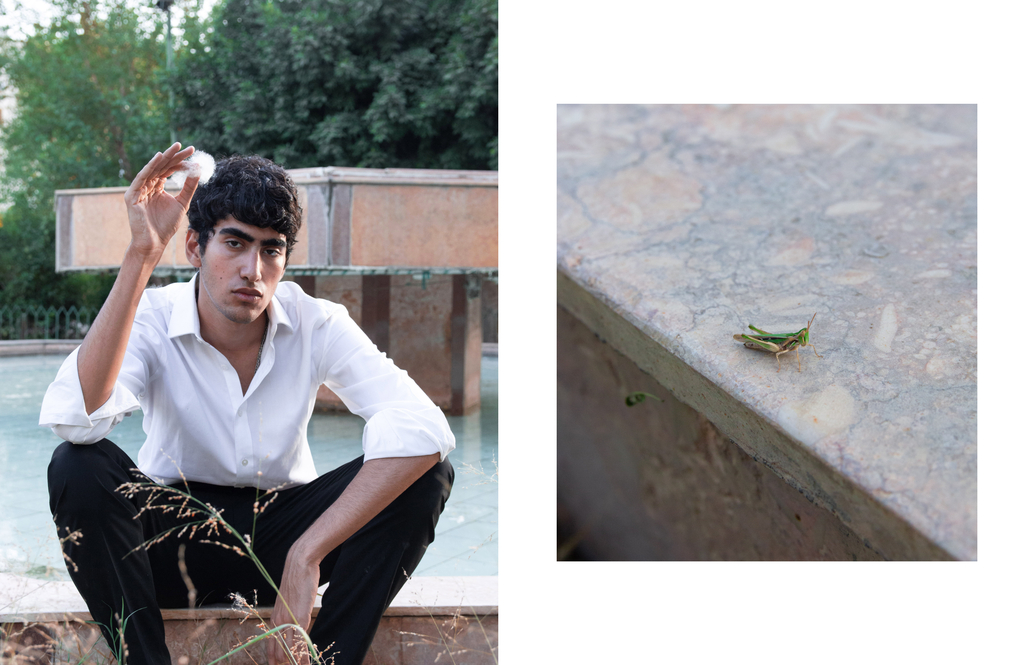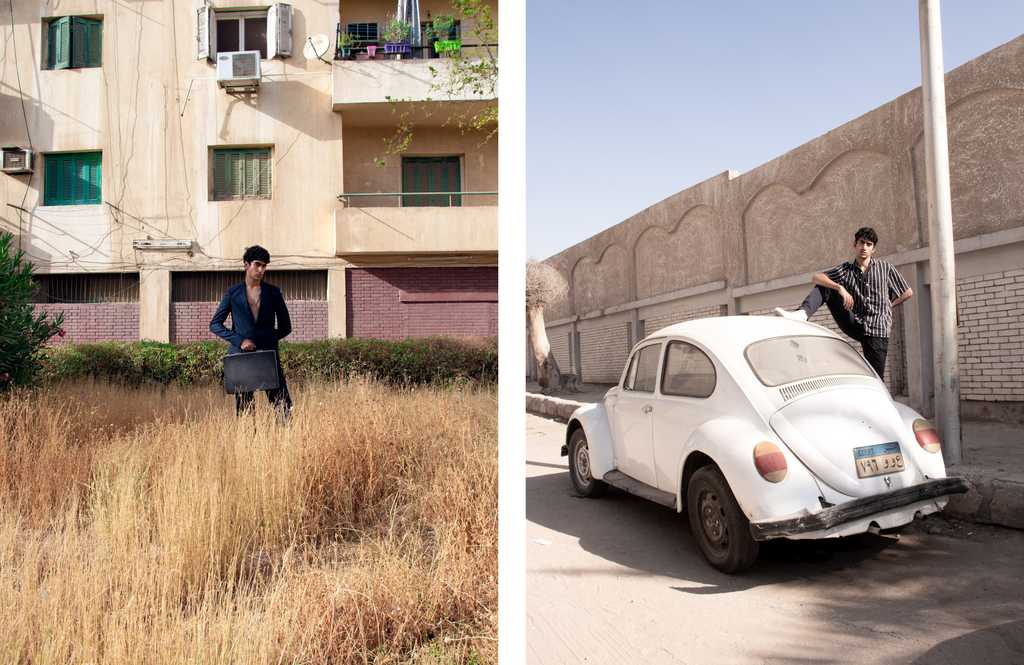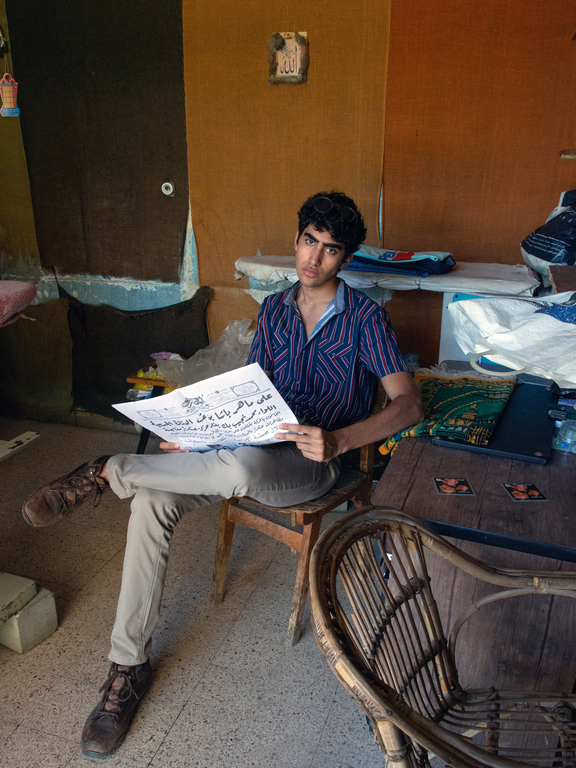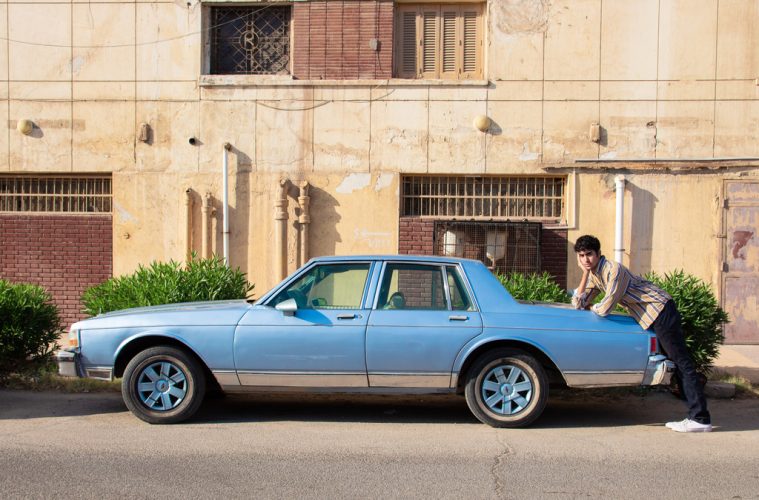Written by Musa Roshdy
Photography by Youssef Sherif
Model Ismaïl
Note: Photography included was not submitted by author but illustrates content of the article.
This article is part of the “Emigration & Desolation” issue
Gender and culture are not like states with clearly-defined borders; they are neither singular nor subject to reductive separations. When I was younger, I never felt particularly Egyptian nor particularly American. My mother stopped speaking Arabic to me after 9/11, when I was four-years-old, for our safety. We were displaced from our home and living out of our car for almost a year, and were facing rising violence against Arabs and anyone who could appear as Arab. Though I lost my ability to speak Arabic, the emphatic sounds of the language echoed through my voice. In fact, when we settled in California, the school district insisted I take speech therapy classes for three years to try to “train away my accent.” Their failure to “fix” my accent was not because they didn’t try, but because of the sounds of Arabic television and music that were always playing in my house. These early exposures were shaping the way I related to the world even though they were beyond my understanding.
Learning through exposure also shaped my conception of gender; I internalized what the narratives and norms I saw playing out at home. My mother worked three times and ensured I received the best education possible. Growing up with her, my understanding of femininity was of strength, intelligence, independence, compassion, and resilience. It was only later that I became aware of society’s larger narratives; they hadn’t occurred to me.
“An Arab of his country and in his country once said to a boy born in a colony: you too are an Arab.” – Omar Sakar from “What It Is to Be Holy”

Photography by Youssef Sherif
I also wasn’t able to place what about myself or my family was particularly Egyptian or particularly American. I knew that we played music loudly, greeted our neighbors while keeping a respectful distance, treated our friends as family, showed up to events 10 minutes early, and that we always put our shoes facing down and took them off when we entered the house.
I only came to understand what of these was particularly American and/or Egyptian through traveling to other countries. In the US, people were always searching for where I was “really from”. In Germany, it took only one word for people to immediately identify me as American. In Argentina, people thought I was too sociable and too generous with food to really be American. They often asked me where I learned to share like an Argentine. My answer was always from watching my mother.
Traveling also helped me learn how people contextualize or perceive behaviours differently through their respective cultural code. In Germany, if you bump into someone you know, I found it was often rude to stay and talk to them longer than it took to greet them, as I was infringing on their time. The American in me understood this. In Argentina, it would be rude to see someone you know and not stop and ask how they were. The emphasis of the interaction, not being on an individual’s time, but on your shared connection. This made sense to the Egyptian in me. This time showed me that I truly am the child of two cultures.
“And every day for seven moons I proclaimed my Joy from the house-top—and yet no one heeded me. And my Joy and I were alone, unsought and unvisited.” – Kahlil Gibran from “And When My Sorrow was Born”
This relativity of behaviour and cultural codes might have prolonged and complicated my exploration of my own gender identity. While living in Argentina I got a stud put into my left ear as a form of commitment to exploring more forms of femininity. To me, this was a clearly feminine action that definitely surprised and confused my deeply traditional Egyptian grandmother. But, in California, the only comments I’ve ever received about my stud are about how it makes me look especially masculine. When I wore a jalabiya in the US, people were initially shocked by the foreignness but perceived it as a dress. For me, I associated it with my grandfather, peace be upon him, who embodied my young self’s ideal of masculinity. What was it about their preconceptions that made it so they couldn’t see my gendered joy?
The lack of adequate models I felt I could align with also complicated the process of exploring my gender and culture. White American “androgyny” felt reductive and like an attempt to be genderless. This reductiveness was too close to my early insecurities about culture: I would minimize my Egyptianness in the US and attempt to hide my Americanness when visiting family in Cairo. In both cases, I felt a sense of confusion and was being told that I was constantly out of place when I was being my authentic self. Restrictive cultural norms and white American androgyny seemed to share the same core: a standard of rigidity based on exclusion.

Photography by Youssef Sherif
What I was craving when exploring gender was a concept of nonbinary-ness that is gender-full. A robust understanding of myself would mean I wouldn’t have to deny my masculinity to honor my nonbinary identity and the simple truth that my gender is much more expansive than a single concept. Why should I have to shave my beard to honor my femininity? Now, when I wear my jalabiyas, I’ve learned to give myself permission to be both solidly masculine and fluidly feminine. I do not have to place one cultural understanding over another. I have found the space to view gender not just as a spectrum between male and female, but as a three-dimensional entity, existing in the space between traditional gender norms, cultural crossings, and self-recognition.
“You know who your mother is. As for your father, be your own.” – Mahmoud Darwish from “To a Young Poet”

Photography by Youssef Sherif
Each person has the freedom to find recognition on their own terms, allowing their culture to inform their gender and their gender to inform their culture. I delight in preparing food for my partner, honoring one gendered form of expressing love I learned from watching my grandmother. I find her enduring strength in myself whenever I am frying something and I don’t flinch when the oil splashes onto my hand (a skill she developed through years of frying taʿmiya every Saturday morning for a family breakfast). Another person could rebuke the idea that preparing food, a basic skill needed for survival, should be gendered in any way.
The beauty of an expansive understanding of gender and culture is that we can allow people their nuances. In the same way that I can be both very much American and still deeply Egyptian, I can embrace both femininity and masculinity. Giving space for forms of being that exceeds the boundaries of either category. In these moments of self-recognition, we give ourselves permission to become more of ourselves, both tied to our roots and growing in new directions.
And, by understanding and honoring the rich inner self of others without reducing them to a label, we can also give them the space to define their gender/culture/existence in a way that makes sense for them. They might help us paint a new picture of the world that we can share, blending their and our own experience as we go.

